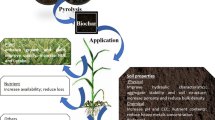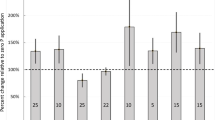Abstract
In search for a source for a slow-releasing K fertilizer, the plant availability of mineral K in selected crushed rocks and mine tailings was investigated by growing Italian ryegrass for six months in small volumes of peat, loamy sand or silt loam mixed with different K-sources. The K supplied as K-feldspar was nearly unavailable to the plants, whereas nearly 60% of the K supplied as biotite and nepheline in a carbonatite, was nearly unavailable to the plants, parts. The carbonate content of the rocks and tailings seemed to be more important for the availability of the K than the specific surface of the mineral particles. It is concluded that a rock-based fertilizer containing biotite as its main K-bearing mineral and between 5 and 20% carbonate, will release K at a slower rate than soluble K fertilizers do and still supply considerably more K to the plants than is supplied from the fraction of non-exchangeable K in the soil.
Similar content being viewed by others
References
Badraoui M, Bloom PR & Delmaki A (1992) Mobilization of non-exchangeable K by ryegrass in five Moroccan soils with and without mica. Plant and Soil 140: 55–63
Barraclough PB & Leigh RA (1993) Critical plant K concentrations for growth and problems in the diagnosis of nutrient deficiencies by plant analysis. Plant and Soil 155/156: 219–222
Berthelin J & Leyval C (1982) Ability of symbiotic and non-symbiotic rhizospheric microflora of maize (Zea mays) to weather micas and to promote plant growth and plant nutrition. Plant and Soil 68: 369–377.
Binet P, elGuessabi L & Salette J (1984) The potassium status of soils: significance of the “Italian ryegrass test”. Fert Res 5: 393–402
Deer W A, Howie R A & Zussman J (1992) An Introduction to the Rock-forming Minerals, 2nd edn. Essex, UK: Longman Scientific & Technical
Egnér H, Riehm H & Domingo WR (1960) Untersuchungen über die chemische Boden-Analyse als Grundlage für die Beurteilung des Nährstoffzustandes der Boden. Kungl. Lantbrukshögskolans Annaler 26: 199–215
Goldschmidt VM & Johnsson E (1922) Glimmermineralernes betydning som kalikilde for planterne. Nor. geol. unders. Bull. 108 (In Norwegian, German summary)
Hinsinger P & Jaillard B (1993) Root-induced release of interlayer potassium and vermiculitization of phlogopite as related to potassium depletion in the rhizosphere of ryegrass. J Soil Sci 44: 525–534
Jakobsen ST (1993) Interaction between plant nutrients III. Antagonism between potassium, magnesium and calcium. Acta Agric Scand, Sect B, Soil and Plant Sci 43: 1–5
Johnston AE & Goulding KWT (1990) The use of plant and soil analyses to predict the potassium supplying capacity of soil. In: Development of K-fertilizer recommendations, pp 177–203. Bern: International Potash Institute
Kretz R (1983) Symbols for rock-forming minerals. Am Mineral 68: 277–279
Kemp A & t'Hart ML (1957) Grass tetany in grazing milking cows. Neth J Agric Sci 5: 4–17
Laronne JB (1986) Rate limitation and dissolution of highly soluble minerals. In: Coleman SM & Dethier DP (eds) Rate of chemical weathering of rocks and minerals, pp 83–91. London: Academic Press Inc
Lasaga AC (1984) Chemical kinetics of water-rock interactions. J Geophys Res 89: 4009–4025
Lasaga AC (1995) Fundamental approaches in describing mineral dissolution and precipitation rates. In: White AF & Brantley SL (eds) Chemical weathering rates of silicate minerals, Reviews in Mineralogy 31, pp 23–86. Washington: Mineralogical Society of America
Mengel K & Rahmatullah (1994) Exploitation of potassium by various crop species from primary minerals in soils rich in micas. Biol Fert Soils 17: 75–79
Mjelde Ø (1983) Geologi og petrografi av nabberen nefelinsyenitt. Cand. real. thesis. University of Bergen, 315 pp. (In Norwegian)
Møberg JP & Nielsen JD (1983) Mineralogical changes in soils used for K-depletion experiments for some years in pots and in the field. Acta Agric Scand 33: 21–27.
Sanz Scovinio JI & Rowell DL (1988) The use of feldspars as potassium fertilizers in the savannah of Colombia. Fert Res 17: 71–83
Sparks DL & Huang PM (1985) Release of soil potassium by weathering reactions. In: Munson RD (ed) Potassium in Agriculture, pp 202–276. Madison, Wisc: American Society of Agronomy
Strand T (1981) Lillebukt alkaline kompleks; karbonatittens mineralogi og petrokjemi. Cand. real. thesis, University of Bergen, 287 pp. (In Norwegian)
Weerasuriya TJ, Pushpakumara S & Cooray PI (1993) Acidulated pegmatic mica: A promising new multi-nutrient mineral fertilizer. Fert Res 34: 67–77
Wentworth SA & Rossi N (1972) Release of potassium from layer silicates by plant growth and by NaTPB extraction. Soil Sci 113: 410–416
Yli-Halla M (1992) Release of K from biotite and K-feldspar. Proceedings of the 14th General Meeting of the European Grassland federation, pp. 562–564
Yläranta T, Uusi-Kämppä J & Jaakkola A (1996) Leaching of phosphorus, calcium, magnesium and potassium in barley, grass and fallow lysimeters. Acta Agric Scand, Sect B, Soil and Plant Sci 46: 9–17
Author information
Authors and Affiliations
Rights and permissions
About this article
Cite this article
Bakken, A.K., Gautneb, H. & Myhr, K. The potential of crushed rocks and mine tailings as slow-releasing K fertilizers assessed by intensive cropping with Italian ryegrass in different soil types. Nutr Cycl Agroecosyst 47, 41–48 (1996). https://doi.org/10.1007/BF01985717
Received:
Accepted:
Issue Date:
DOI: https://doi.org/10.1007/BF01985717




